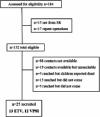Comparing motor development in children with hydrocephalus after treatment with ventriculoperitoneal shunt and endoscopic third ventriculostomy: a cross-sectional study
- PMID: 39086370
- PMCID: PMC11287813
- DOI: 10.4314/mmj.v36i1.2
Comparing motor development in children with hydrocephalus after treatment with ventriculoperitoneal shunt and endoscopic third ventriculostomy: a cross-sectional study
Abstract
Introduction: Ventriculoperitoneal shunt insertion (VPSI) and endoscopic third ventriculostomy (ETV) are the major procedures for treating pediatric hydrocephalus. However, studies comparing motor development following the two treatments are limited.
Objective: We aimed to determine motor development outcomes in children with hydrocephalus up to 2 years of age after undergoing VPSI or ETV, to identify which surgical approach yields better motor outcomes and may be more effective for Malawian children.
Methods: This was a cross-sectional study where we recruited two groups of participants: one group consisted of children with hydrocephalus treated with VP shunt whilst the other group were treated with ETV, at least 6 months prior to this study. Participants were identified from the hospital records and were called to come for neurodevelopmental assessment using the Malawi Development Assessment Tool (MDAT).
Results: A total 152 children treated for hydrocephalus within an 18-month period met the inclusion criteria. Upon follow up and tracing, we recruited 25 children who had been treated: 12 had VPSI and 13 had ETV. MDAT revealed delays in both assessed motor domains: 19 out of the 25 children had delayed gross motor whilst 16 of 25 had delayed fine motor development. There was no significant difference between the shunted and the ETV groups.
Conclusion: Children with hydrocephalus demonstrate delays in motor development six to 18 months after treatment with either VPSI or ETV. This may necessitate early and prolonged intensive rehabilitation to restore motor function after surgery. Long-term follow-up studies with bigger sample sizes are required to detect the effect of the two treatment approaches.
Keywords: Hydrocephalus; Malawi; Malawi Development Assessment Tool; motor development; ventriculoperitoneal shunt; ventriculostomy.
© 2024 Kamuzu University of Health Sciences.
Figures
References
-
- Hetherington R, Dennis M. Motor function profile in children with early onset hydrocephalus. Dev Neuropsychol. 2009;15(1):25–51.
-
- Isaacs AM, Riva-cambrin J, Yavin D, Hockley A, Pringsheim TM, Jette N, et al. Age-specific global epidemiology of hydrocephalus : Systematic review, metanalysis and global birth surveillance. PLoS One [Internet] 2018;13(10):1–24. doi: 10.1371/journal.pone.0204926. Available from: - DOI - PMC - PubMed
-
- Dewan MC, Rattani A, Mekary R, Glancz LJ, Yunusa I, Baticulon RE, et al. Global hydrocephalus epidemiology and incidence: systematic review and meta-analysis. 2019 April;130:1065–1079. - PubMed
Publication types
MeSH terms
LinkOut - more resources
Full Text Sources
Medical
Miscellaneous

